|
Thursday, July 31
- Breakfast: Canadian bacon, egg and cheese Texas toast
- Breakfast: Mexican omelet
- Western barbecue burger
- Smart cuisine: braised beef with vegetables
- Carolina barbecue chicken
- Baked ham and Swiss ciabatta
- Sweet and sour chicken
- Beef barley soup
- Chef's choice soup
- Assorted pizza by the slice
Wilson Hall Cafe menu |
|
Friday, Aug. 1
Dinner
Closed
Wednesday, Aug. 6
Lunch
- Lemongrass shrimp over rice vermicelli and vegetables
- Jasmine chai rice pudding
Chez Leon menu
Call x3524 to make your reservation.
|
|
Giant electromagnet completes its journey, moves into its new home at Fermilab
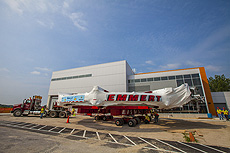 |
The 50-foot-wide Muon g-2 electromagnet rests in front of the new building that will house the experiment. The building was constructed over the past year. Photo: Cindy Arnold
|
Editor's note: ABC7's three-minute news video on the Muon g-2 magnet move was broadcast Wednesday evening.
One year ago, the 50-foot-wide Muon g-2 electromagnet arrived at the U.S. Department of Energy's Fermi National Accelerator Laboratory in Illinois after traveling 3,200 miles over land and sea from Long Island, New York. This week, the magnet took the final few steps of that journey, moving across the Fermilab site and into the new building that now houses it.
The gigantic electromagnet is the centerpiece of Fermilab's Muon g-2 experiment, which will investigate the properties of an elusive subatomic particle called the muon. Since its arrival at Fermilab on July 26, 2013, the magnet has been biding its time, waiting for the completion of the new building on site that will house the experiment.
That building was finished in April, and in a series of two moves over the past six days, the ring was transported across the Fermilab site and slowly pulled into place on huge metal tracks. A crowd of scientists and enthusiasts were on hand to cheer the magnet on and applaud the next phase of muon physics at Fermilab.
"We're all very excited to see this device move that last mile and be put in place," said Chris Polly, project manager for the Muon g-2 experiment. "For those of us who have been working on this for years, it's a great moment, and it brings us closer to taking data and having our questions answered."
Read more
View ABC7's three-minute video on the move
|
August wellness offerings, fitness classes and discounts
Walk 2 Run
Two time slots for Walk 2 Run are available this fall.
This free 10-week program teaches you to run, improves fitness and assists in losing weight and lowering cholesterol. All are welcome regardless of age, speed or experience. Wear athletic shoes. A minimum of six participants per session is required. Please RSVP to Jeanne Ecker at jecker@fnal.gov if you are interested.
Fitness classes
Yoga Thursdays
Thursdays, Aug. 7-Oct. 2 (eight weeks), noon to 12:45 p.m.
One vacation day, TBD during session
WHGFE Training Room
$60/person/eight-week session. Register by July 31
Yoga Mondays
Mondays, Aug. 11-Sept. 29 (six weeks), noon to 12:45 p.m.
No class Sept. 1. One additional vacation day TBD
WHGFE Training Room
$45/person/six-week session. Register by Aug. 4
Zumba Toning
Tuesdays, Aug. 26-Oct. 14, 11:45 a.m.-12:30 p.m.
Fitness Center Exercise Room
$50/person. Register by Aug. 19
Zumba Fitness
Thursdays, Aug. 28-Oct. 16, 11:45 a.m.-12:30 p.m.
Fitness Center Exercise Room
$50/person. Register by Aug. 21
Butts and Guts
Wednesdays, Sept. 3-Oct. 8, 11:45 a.m.-12:30 p.m.
Fitness Center Exercise Room
$60/person. Register by Aug. 27
Employee club
Fermilab Tango Club
Thursdays, 5-7 p.m.
Ramsey Auditorium
Free beginner tango lessons. For information, email tangoclub@fnal.gov.
Athletic leagues
Pickup volleyball games
Tuesdays, 5:30 p.m.
Fermilab Village sand volleyball courts
All are welcome to join the fun.
Outdoor soccer
Tuesdays and Thursdays, 6 p.m.
Fermilab Village soccer field
Contact O'Sheg Oshinowo for more information
Employee discount
Visit the Employee Discounts Web page.
For more information or to register for a class, visit the Wellness Web page.
|
JUNO International Collaboration established
From Interactions.org, July 30, 2014
During this hottest season in Beijing, hundreds of scientists from all over the world gathered at the Institute of High Energy Physics (IHEP) to announce the establishment of the International Collaboration of the Jiangmen Underground Neutrino Observatory (JUNO).
Read more
|
|
Which Higgs?
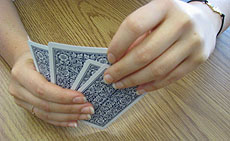 |
| How many electroweak symmetry-breaking doublets are in that hand? Photo: Leo Bellantoni
|
Disponible en español
With all the discussion about "the Higgs," it is worth remembering that what Peter Higgs (and Robert Brout, François Englert, Gerald Guralnik, Carl Hagen and Tom Kibble) gave us was not at first a particle. Originally, it was a trick.
Specifically, it was a mathematical trick to solve a particular physics problem — the problem of how to retain a lovely property called gauge invariance and still allow massive particles in the theory. The trick is to add mathematical expressions to the theory that have what are called doublets.
Now, that trick can be played more than one way. If the trick is played in the simplest way, by adding one doublet, the existence of one and only one new particle is predicted; that is the particle that we usually call "the Higgs." But there is no particular reason to believe that the simplest way is how nature is playing with us. The next simplest play has two of these doublets and predicts both three new neutral particles and a pair of charged particles. There are many other ways in which nature might be playing its cards.
One way to figure out what is in this hand of cards is to measure the spin and parity of the Higgs that has been found. The spin of a particle is its intrinsic angular momentum; the parity has to do with how the particle's interactions will appear if they are viewed in a mirror.
If there is only one doublet and there is only one Higgs boson, then the spin must be zero and the parity must be even. If there are two doublets and if we have found one of those three neutral particles, then the particle we have found must have a spin of zero but it might not have even parity. It could have an odd parity or be a mixture of even and odd parity. Because the found Higgs decays into a pair of photons, it can not have a spin of one; but a spin of two and a positive parity is possible in some theories with extra dimensions.
Although the spin and parity are properties of the particle itself and do not depend on what the particle decays into, it is valuable to check that one obtains the same result regardless of what the particle decays into. For this reason, DZero has leveraged the comparative advantage of the Tevatron to set constraints on the spin and parity of the Higgs that has been found in the case where it decays into a pair of bottom quarks.
The DZero result suggests that nature is playing the simplest hand — the single-doublet scenario. Comparing odd to even parities for the spin zero case, the odd parity hypothesis is disfavored with 97.6 percent confidence. Comparing spin zero to spin two for the even parity case, the spin two hypothesis is disfavored with 99.0 percent confidence. However, this does not quite prove that there is only one doublet. It is possible to get the same result with two doublets. We shall have to see a few more cards before we know exactly what is in that hand!
—Leo Bellantoni
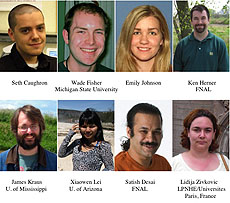 |
| These DZero members all made significant contributions to this result. |
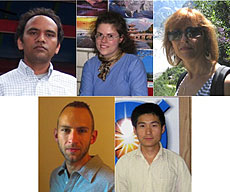 |
| The DZero collaboration thanks these members of the collaboration, who have ensured the highest quality of scientific output from DZero by serving as physics group conveners until this summer: Ashish Kumar (State University of New York, Buffalo), Yvonne Peters (University of Manchester, England), Elizaveta Shabalina (Georg-August Universität, Göttingen, Germany), Mark Williams (Indiana University), Hang Yin (Fermilab). |
|
Wilson Hall and the Milky Way
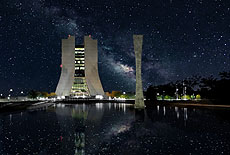 |
| Two photos — those of Fermilab and the Milky Way — are combined in this image as homage to the work of the laboratory in discovering the secrets of our universe. Photo: Alan Amati
|
|
|